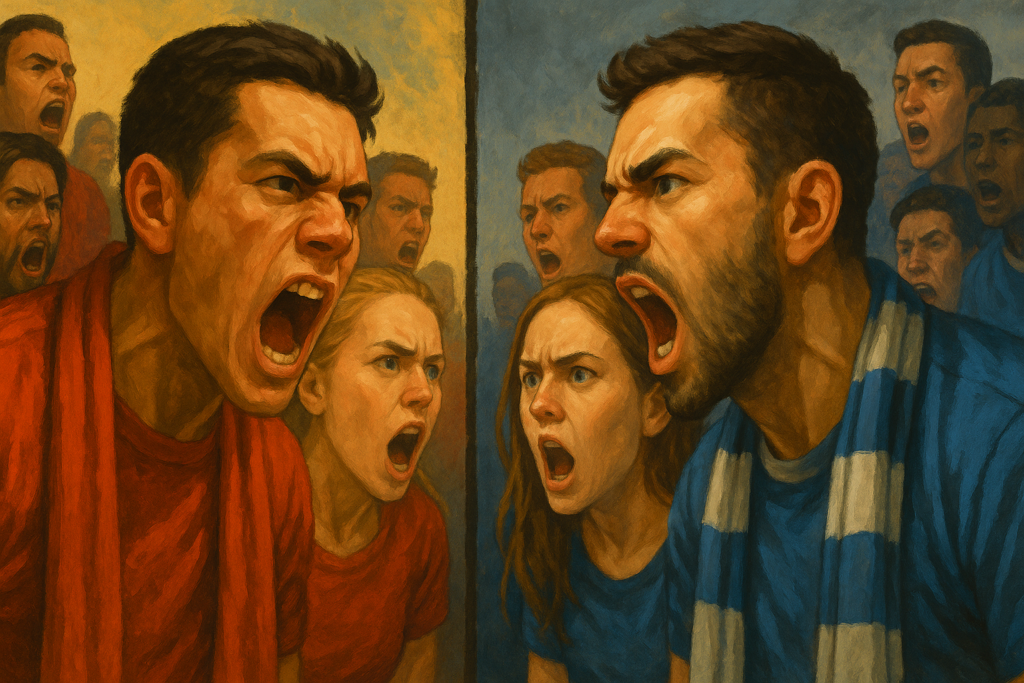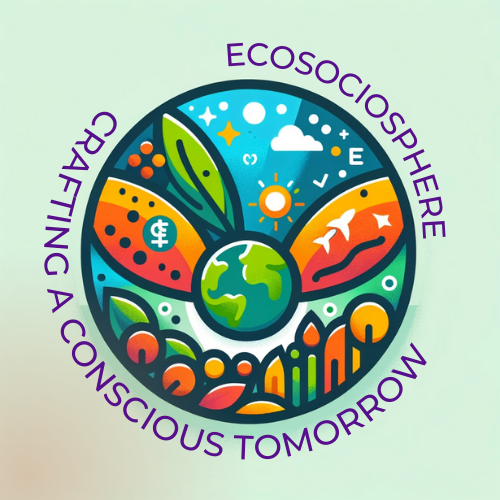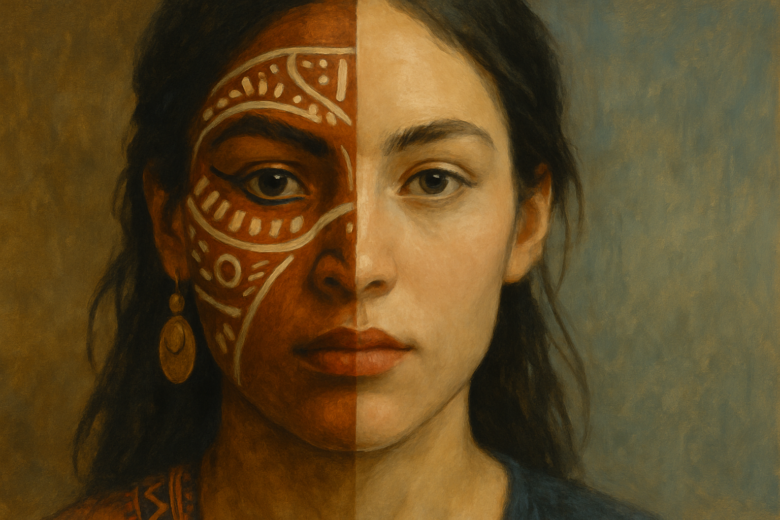Fun Fact: Even toddlers as young as 3 years old tend to prefer people who speak their native language—hinting that our instincts to form “in-groups” start shockingly early.
Have you ever felt uncomfortable in a room full of strangers, but totally at ease among your own “people”? Or instinctively rooted for one sports team—not because of skill, but because “they’re ours”? These aren’t just social quirks. They’re deep evolutionary behaviours.
Welcome to the psychology of tribalism. It’s not just about ancient clans fighting over land. It’s in our politics, our fandoms, our social media bubbles—and perhaps, even our DNA. So the question is: are we wired for tribalism?
From Savanna to Society: The Origins of In-Groups
Let’s go back about 200,000 years. Early Homo sapiens lived in small hunter-gatherer bands. Survival depended on trust—trust that your group would share food, protect each other, and not abandon you in a crisis. Strangers? They were potential threats.
Evolution favoured those who could quickly distinguish “us” from “them.” In-group loyalty meant survival. Out-group suspicion meant caution. And over thousands of generations, our brains adapted to this reality.
This ancient wiring still lives on in our modern minds—even though we now share cities, countries, and Instagram feeds with millions of people we don’t personally know.
What Are In-Groups and Out-Groups?
In psychology, in-groups are groups we feel we belong to—our family, culture, religion, caste, nation, even a college alumni network. Out-groups are everyone else.
And here’s the kicker: once we mentally divide the world this way, everything changes. We trust in-groups more. We give them the benefit of the doubt. We see out-groups as less trustworthy, less empathetic, and even less human.
Yes, less human.
A study at Princeton University found that when participants looked at photos of homeless people or drug addicts—perceived “out-groups”—the brain areas associated with empathy (like the medial prefrontal cortex) showed significantly less activity.
That’s not just bias. That’s dehumanization—at a neural level.
The Minimal Group Experiment: Tribalism on Steroids
In the 1970s, psychologist Henri Tajfel conducted a groundbreaking study. He randomly assigned boys into groups based on arbitrary criteria—like a preference for paintings. Despite the groups being meaningless, participants quickly showed favouritism toward their own group and discrimination against the others.
This was called the minimal group paradigm, and it shocked researchers. Just creating a group—any group—was enough to spark tribal behaviour. You didn’t need shared values, culture, or history. All it took was a label.
Sound familiar in today’s politics?

Real-World Examples: From Football Fields to Warzones
Sports Fandom
Think Manchester United vs. Liverpool. Or India vs. Pakistan in cricket. The emotions are intense, irrational, and often echo war-like loyalty. Fans wear team colors like uniforms, chant battle cries, and feel genuine rage when their side loses. This is tribalism dressed up as entertainment.
Politics
Right-wing vs. left-wing. Nationalist vs. liberal. In many countries, including India and the United States, political identities are now as tribal as religion once was. People don’t just disagree—they despise the other side.
A 2020 Pew Research Centre study showed that over 70% of Democrats and Republicans in the U.S. view each other as “immoral” and “dangerous.” We’re not just debating ideas—we’re protecting our tribe.
Religion and Ethnicity
Historically, some of the bloodiest conflicts—whether in Rwanda, the Balkans, or the Middle East—have roots in tribalism. Religious and ethnic lines draw in-groups so powerful that they override logic, empathy, and even self-preservation.
Social Media: Tribalism 2.0
In the digital world, tribalism thrives.
Algorithms on platforms like Meta (parent company of Facebook and Instagram, which operates global social media and advertising platforms) or X (formerly Twitter, now owned by X Holdings and operated as a social media and news-sharing platform) are designed to reinforce echo chambers. You see content that aligns with your views. You engage with your group. You block the rest.
This digital tribalism fuels cancel culture, online mobs, and filter bubbles. It gives us a false sense of “us vs. them”—magnifying division on everything from vaccines to fashion choices.
And ironically, the more connected we become, the more divided we feel.
Are There Benefits to Tribalism?
Absolutely. Tribalism isn’t all bad.
- Community & Belonging: Humans crave connection. Being part of a group gives us purpose, identity, and support.
- Shared Morality: In-groups often help us uphold collective values.
- Coordination: Tribes work together. In emergencies, in-groups rally faster and more effectively.
Tribalism helped build cities, defend nations, and create cultures. But the same wiring can also justify prejudice, exclusion, and violence.

Can We Outgrow Our Tribal Minds?
Here’s the challenge: we can’t change our evolutionary wiring—but we can override it.
Expand the In-Group
The trick is to broaden the definition of “us.” Psychologists call this recategorization. Instead of “my caste vs. yours,” we shift to “we’re all Indians.” Instead of “my party vs. yours,” how about “we both want a better future”?
Create Cross-Group Friendships
Studies show that even a single friendship across group lines reduces bias. Dialogue, empathy, and exposure disrupt tribal thinking.
Make Shared Goals
When people work together—on climate change, public health, or education—they bond beyond their groups. That’s how soldiers become brothers, even if they come from different races or religions.
A New Kind of Tribe
Maybe the problem isn’t tribalism—it’s the kind of tribes we’re forming.
What if we created tribes not based on blood, belief, or birthplace—but on values? A tribe of kindness. Of climate action. Of lifelong learners. Of equality-seekers. Of peace-builders.
Because we’ll always seek “us.” That’s human. The real work is deciding who “us” includes.
Conclusion: The Tribal Mind and the Modern World
Yes, we are wired for tribalism. But our brains also evolved the prefrontal cortex—the part that lets us reflect, reason, and choose. We’re not prisoners of our past. We can decide to build bridges instead of boundaries.
The next time you feel that gut reaction against “them,” ask yourself: Who taught me that? Is it ancient instinct—or modern manipulation?
Because in the end, the real enemy isn’t “them.” It’s the walls we build in our minds.
Author’s Note
This blog explores the evolutionary roots of group behaviour, not to shame tribalism, but to understand it. Once we understand the origins, we can start building more inclusive tribes—ones that connect instead of divide.
G.C., Ecosociosphere contributor.


